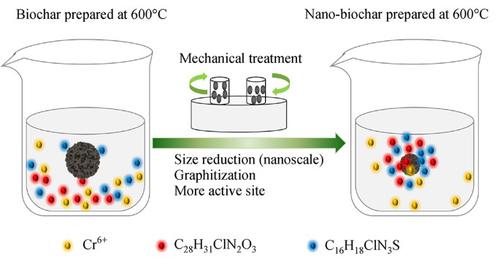Frontiers of Environmental Science & Engineering ( IF 6.1 ) Pub Date : 2021-03-25 , DOI: 10.1007/s11783-021-1418-2 Peidong Su , Xiangyu Gao , Junke Zhang , Ridha Djellabi , Bo Yang , Qi Wu , Zhen Wen

|
Biochar (BC) has been extensively studied as adsorbent for the treatment of water pollution. Despite the distinct advantages, the high calcination temperature and low adsorption capacity of pristine BC limit its practical applications. Most of the former studies focused on the structure and/or surface modification to improve the adsorption capacity of BC. However, the harsh experiment conditions involved in the biochar modification limited the application in industrial level. Herein, we introduced mechanical treatment into BC preparation to reduce the calcination temperature and improve the adsorption capacity simultaneously. The results indicated that the calcination temperature was reduced and the adsorption capacity of the treated BC was improved after mechanochemical treatment. Characterization of the samples disclosed that BCs were graphitized with the particle size reduced to nanoscale after treatment. Adsorption tests indicated that the mechanochemically treated BCs showed much better removal performance of organic contaminants than that of pristine BCs. For instance, among four pristine BCs (BC600, BC700, BC800, and BC900), only BC900 has strong adsorption capacity for MB, while BC600 has low adsorption capacity (1.2 mg/g). By comparison, the adsorption capacity of MB increased greatly to 173.96 mg/g by BC600-500/1 (treated at 500 r/min for 1 hour). To optimize the mechanochemical treatment, the effects of rotation speed and agitation duration were also investigated.
中文翻译:

机械化学石墨化增强生物炭的吸附功能以去除有机污染物
Biochar(BC)作为吸附剂用于水污染的处理已被广泛研究。尽管具有明显的优势,但原始BC的高煅烧温度和低吸附能力限制了其实际应用。以前的大多数研究都集中在提高BC吸附能力的结构和/或表面改性上。然而,生物炭改性所涉及的苛刻实验条件限制了其在工业水平上的应用。在这里,我们将机械处理引入BC制备中以降低煅烧温度并同时提高吸附能力。结果表明,机械化学处理后,降低了煅烧温度,提高了处理后的BC的吸附能力。样品的表征公开了在处理后将BCs石墨化,其粒径减小至纳米级。吸附测试表明,机械化学处理过的BCs去除有机污染物的性能比原始BCs更好。例如,在四种原始BCs(BC600,BC700,BC800和BC900)中,只有BC900对MB的吸附能力强,而BC600的吸附能力低(1.2 mg / g)。相比之下,通过BC600-500 / 1(以500 r / min处理1小时),MB的吸附容量大大增加至173.96 mg / g。为了优化机械化学处理,还研究了转速和搅拌持续时间的影响。吸附测试表明,机械化学处理过的BCs去除有机污染物的性能比原始BCs更好。例如,在四个原始BCs(BC600,BC700,BC800和BC900)中,只有BC900对MB具有很强的吸附能力,而BC600具有较低的吸附能力(1.2 mg / g)。相比之下,通过BC600-500 / 1(以500 r / min处理1小时),MB的吸附容量大大增加至173.96 mg / g。为了优化机械化学处理,还研究了转速和搅拌持续时间的影响。吸附测试表明,机械化学处理过的BCs去除有机污染物的性能比原始BCs更好。例如,在四种原始BCs(BC600,BC700,BC800和BC900)中,只有BC900对MB的吸附能力强,而BC600的吸附能力低(1.2 mg / g)。相比之下,通过BC600-500 / 1(以500 r / min处理1小时),MB的吸附容量大大增加至173.96 mg / g。为了优化机械化学处理,还研究了转速和搅拌持续时间的影响。BC600-500 / 1(以500 r / min处理1小时)对MB的吸附能力大大提高至173.96 mg / g。为了优化机械化学处理,还研究了转速和搅拌持续时间的影响。BC600-500 / 1(以500 r / min处理1小时)对MB的吸附能力大大提高至173.96 mg / g。为了优化机械化学处理,还研究了转速和搅拌持续时间的影响。











































 京公网安备 11010802027423号
京公网安备 11010802027423号